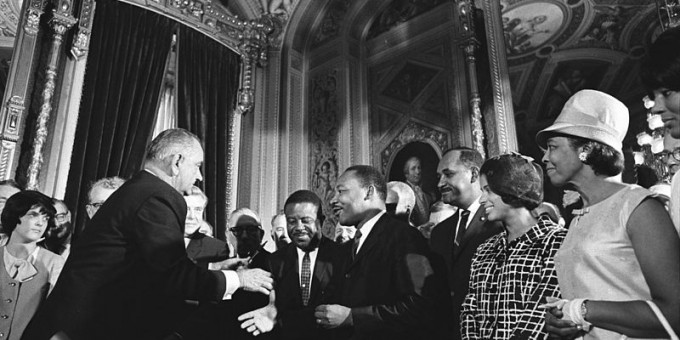
We are not a fully democratic country. We never have been and now are moving only very slowly in that direction. To understand the 2012 election and key political events in the Obama era, we must look at the larger societal context—at institutional fundamentals. Systemic racism is central in that institutional context, and especially in our political system.
Our political institutions were built by elite white male founders (40% of the participants at the U.S. constitutional convention being slaveholders and many of the rest profiting off the slavery system). These men and their descendents built political institutions to protect their racial and class interests, and many were undemocratic or antidemocratic: a Constitution aggressively designed to protect enslaved property; a Senate representing land areas and powerful whites far more than ordinary people; an unelected Supreme Court of elite whites trumping acts of Congress; and an elite white male president chosen by an undemocratic Electoral College. There are too many undemocratic capitalistic institutions to list, all also made and maintained mostly by elite white men substantially to protect their political-economic interests.
Even today, the United States is substantially run by an elite oligarchy that is mostly white male. The current Congress is overwhelmingly white and male. The Senate is 96% white and 81% white men. The House is 83% white and 72% white men. With only two exceptions (Nancy Pelosi and Barack Obama), the top spots in Congress and the White House have always been held by elite white men. And today, elite white men today make up fully 93% of the CEOs of Fortune 500 companies.Whoever wins the 2012 election, a small oligarchy of white men will still firmly control America’s major political-economic institutions.That is our current context. Because of our elite-run institutions, the 2012 election won’t come close to being democratic in operation or structure: voters got to vote for white-male-elite-chosen, well-off candidates—choosing between a prototypical rich white man or a black man vetted by and financially indebted to elite whites. Whoever won, a small oligarchy of white men would still firmly control our major political-economic institutions.
Astoundingly, the “founders” and their powerful descendants are still rarely called out as elite white men and researched systematically as such by social scientists.
Racially Polarized Electorates
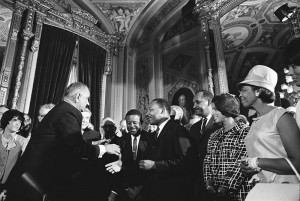
Until the 1960s almost all American voters were white. The end of Jim Crow brought a significant increase in voters of color and their important electoral organizations. Since the 1970s, the Democratic Party has been much more racially diverse than the Republican Party, with many liberal leaders and with diverse activists and voters from all racial groups. In contrast, the Republican Party has become in effect the “white party” of the United States in terms of overwhelmingly white leaders, activists, membership, and party positions favoring white interests. Over recent decades, substantial growth in and among voters of color has, in fact, gradually changed U.S. politics. However, as Sean Theriault and other political analysts have shown, the racial and political polarization of major parties in Congress has stemmed from party caucuses becoming less politically diverse, as white southern Democrats have been replaced by numerous white Republicans and some Democrats of color, and white northern Republicans have become significantly more conservative.
This growth of two substantially different electorates is a clear sign of contemporary systemic racism. One electorate is very diverse with lots of voters of color—who turn out best for presidential elections and tend to vote for typically more liberal Democratic candidates. The other is mostly made up of white voters with better turnout rates, especially for nonpresidential elections, and tends to vote for conservative Republican candidates. According to the analyses of social commentator Bill Bishop, in the 2008 election, about half of all presidential votes were in politically and racially polarized counties in which either Obama or McCain won by at least 20%. The percentage of voters in these “landslide” counties has doubled since 1976, and is related to persistent and substantial residential segregation. Counties in which McCain won with a landslide margin were overwhelmingly white. In Obama’s landslide counties, black and Latino residents averaged 43% of the voting age population.In numerous recent local, state, and national elections, voters of color have increasingly been key. A majority have typically shown opposition to white-oriented Republican candidates and party positions. They typically support large-scale government action aimed at socioeconomic opportunities and upward mobility, such as major education and jobs programs that can help all Americans to achieve the “American dream.”
In the 2008 election, a substantial majority (55%) of whites opted for McCain (including 59% of white men). So, Obama was elected in large part because of his overwhelming majority among voters of color. Exit polls showed the latter cast ballots for him in large majorities: 95% of blacks, 67% of Latinos, 62% of Asian Americans, and about 70% of Native Americans. If only white voters had been able to decide the presidential race in pivotal states—such as Florida, Ohio, and Virginia—McCain would have won those states and the general election in a landslide.
A Political “Outsider Within”
Barack Obama is the first person of color to ever gain entry into the highest inner sanctum of the U.S. political elite. In our political system, President Obama has been a classical “outsider within”—a designation that comes with major political disadvantages. For example, numerous liberal analysts have called on him to act like previous presidents who aggressively sought liberal policies, such as Franklin Roosevelt did with 1930s social welfare, New Deal programs across the country. Yet Roosevelt was a consummate white insider with stellar elite connections. In his political and governing efforts, Obama has had to depend, in many ways, on the vacillating sponsorship of white men in the moderate segment of the elite for help in gaining political advances. Often, he hasn’t had nearly the economic, political, or social capital needed to take aggressive action on key public policies that a full-fledged member of the white elite would likely have.
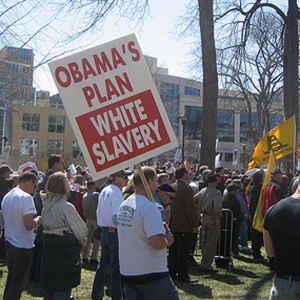
Over the past five years, hundreds of thousands of racist attacks have been made on Obama’s candidacy and presidency by white conservatives, including those supporting Republican candidates. He has regularly faced intensive racist framing that insists upon, and reinforces, his outsider status in the minds of white conservatives. For example, many Tea Party activists, almost all white, place great emphasis on racial and identity issues—such as where Obama was born and his alleged African-ness. Throughout his political years, vicious imagery had been applied to Obama and his family by both powerful and ordinary whites. In just one example of thousands, according to numerous press reports, in February 2012, a white chief federal district judge used an official courthouse address to Email acquaintances a “joke” suggesting that Obama’s mixed ancestry might stem from his mother’s carousing at a party, and that she might even have had sex with a dog—somehow linking white-black interracial sex to possible sexual bestiality. Such mongrelizing imagery for black Americans is familiar—it’s old, white, racist framing, and its extensive use even today signals a still systemic racism.
Even under such attacks, fears about the racial framing of potential white supporters have kept Obama’s campaign from speaking substantially about U.S. racism. In the 2008 campaign, only once did his camp explicitly call out racism, and that was because media attacks on Obama’s distinguished black pastor, Dr. Jeremiah Wright, forced their hand. Sensitive to views of elite and other white backers, White House officials and campaign advisers have since urged President Obama to continue with a pragmatic, moderate political orientation that doesn’t deal openly with racism (thus appealing to white independents and moderate Democrats). They haven’t pressed for any major new anti-discrimination laws or major new economic stimulus programs to create jobs for ordinary Americans, especially Americans of color who still face depression-level unemployment. Recent comments by David Axelrod, Obama’s senior political adviser, have signaled this pro-white strategy. Asked on a May 2011 (MSNBC) Meet the Press episode if racism was involved in hostile “birther” attacks, an unusually hesitant Axelrod said, “I have not had that discussion with [Obama], and frankly I’m not going to entertain that question. I don’t think that’s a worthy question because, in that sense, I don’t think it’s, I don’t think it’s, I don’t think—but I don’t think, I don’t think we… I think a lot of Americans were offended by it. Of all stripes.” Axelrod’s evasion was just another glimpse of the impact of white racial framing and other systemic racism on contemporary U.S. politics.
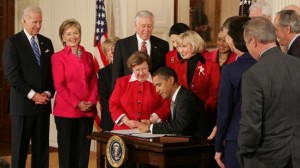
Obama clearly has progressive policy impulses, but has often been blocked or restricted by the conservative wing of the white elite operating through Republicans in Congress. As he reveals in his books, he is well aware of the racial hostility he and other Americans of color face, but he has accomplished a great deal in spite of sustained opposition, albeit frequently under the radar. For example, he worked with his Department of Justice to focus on doggedly enforcing civil rights laws, including hiring many more lawyers experienced in rights litigation. His administration submitted a human rights report under the United Nations Human Rights Council’s review process. As noted well by researcher Robert Watson and reported by investigative journalists like Will Moredock, among others, Obama has worked to expand funding of black colleges; pass hate crimes and health care legislation; enforce equal pay for women; end the military’s “Don’t Ask, Don’t Tell” policy; end federal defense of DOMA; remove the stem-cell research ban; provide new funding for child health; expand student and small business loans; and nominate the first Latina Supreme Court justice. By means of a cautious and pragmatic progressive approach, and usually with support from the moderate wing of the elite, Obama has been able to achieve certain socially liberal political goals.
2010 Republican Electoral Surge
That pragmatic-liberal, sometimes rights-related action and the fact that Obama is black account for much of the white backlash against him. In the 2010 elections, the portion of white voters opting for Republican House candidates increased, setting a record at 60%. Just 37% of whites chose Democratic candidates. The Democratic Party lost the House and some Senate seats. According to detailed reports by Ronald Brownstein and other reporters at the National Journal, in July 2012 national polls revealed that Obama was supported by only 28% of noncollege white men and 37 to 40% of college-educated white men, down from 39 and 42%, respectively, in 2008. His percentage among non-college white women was 37 to 40% and among college-educated white women, 49 to 52% (both figures also down a little from 2008). The same polls showed Obama again getting the overwhelming majority of 69 to 76% of voters of color.
So it is that many political observers now view the 2012 election as a battle between a still heavily white, conservative electorate (with some arguing that, to win, Romney must get at least 60% of white voters—or that Obama must get at least 40% of them) and a moderate-to-liberal electorate substantially composed of voters of color.Various 2008–2011 exit polls, national surveys, and media commentaries indicate that a great many whites view the Democratic Party and its policymaking as much too oriented to interests of voters of color, especially African Americans. That is probably why the “lazy welfare recipient” imagery in recent Mitt Romney ads, in regard to Obama’s recent decision about making work requirements more flexible for a welfare program, has worked well among whites. Increasingly, a great many whites seem to fear the loss of their great socioeconomic privileges and political power to Americans of color. It’s no wonder so many have joined very conservative political groups like the Tea Party.
Voters of Color and Obama’s Campaign Strategy
Since the major Democratic Party losses in the 2010 elections, Obama and his campaign staff have clearly been aware of these results’ racial and political implications. The Obama team brought in veteran Katherine Archuleta as its political director for 2012—the first-ever Latina. The campaign seems to know well their 2008 victory came from constructing the strongest multiracial coalition and presidential campaign in U.S. history, and they’ll work to rebuild it.
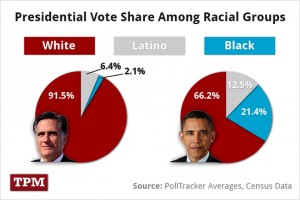
Obama got about 80% of all voters of color in 2008. Their 26% of all voters has increased since, significantly in some states and especially among Latinos. Writing in a July 9, 2012 issue of the New Republic, political and demographic analysts Ruy Teixeira and William Frey offered important data on the shifts in the electorate over recent decades. That 2008 figure marked a major change from the 1992 election, in which 88% of voters had been white, and some 53% non-college whites; by 2008 the comparable figures were substantially lower at 74% and 39%, respectively. Significantly, the percentage of eligible voters of color among all voters has increased nationally by 3% since 2008. The share for working-class whites has decreased by that amount, and college-educated whites’ share of the votes has stayed about the same. Increases in voters of color are particularly dramatic in “swing” states: in Nevada, the share has increased by 9%; in Colorado, 3%; in North Carolina and Florida, about 4%. In contrast, the shares of noncollege white eligible voters have decreased in all four states.
One important strategy for the Obama campaign will include getting these eligible voters registered and enthusiastic about voting. Obama’s sometimes low-key approach on certain issues of great concern to them has periodically lessened enthusiasm and turnout, even as aggressive, mostly white-run, Republican attempts to block voters of color have been found in numerous states. In Pennsylvania, the Republican leader in the state House asserted plainly that his state’s new voter identification law would “allow Governor Romney to win Pennsylvania.” New York University’s Brennan Center’s president Michael Waldman recently summarized their report naming 19 states that “rushed through new laws that cut back on voting rights [making it] far harder for millions of eligible citizens to vote” and noting that, luckily, the “Justice Department, courts, and voters have blocked or blunted many of these laws.” Yet not all. Significant numbers of voters of color are still likely to be screened out of the 2012 election.
Forever a White Oligarchy?
Extensive data show our political and economic systems remain extraordinarily oligarchical. A very small group of wealthy, overwhelmingly white Americans—the famous “one percent”—have far greater political power and control than ordinary Americans of all backgrounds. Substantial research by Jeffrey Winters and Benjamin Page, among others, has shown they effectively control all major public elections and much important policymaking.
One collaborative study by the Public Campaign, the Fannie Lou Hamer Project, and the William C. Velasquez Institute, titled Color of Money: The 2004 Presidential Race, found that 90% of those contributing more than $200 to federal political campaigns lived in predominantly white zip codes, more than half in well-off areas. Political investors representing just one third of one percent of the population contributed two-thirds of all money from individuals. Manhattan’s wealthy white Upper East Side led in what some called the “wealth election,” one in which presidential and other political candidates must aggressively compete in our undemocratic system. It’s more true than ever for the 2012 election.
When it comes to a cohesive, white male elite and its most sought-after political and economic goals (think of the federal bailout of Wall Street, even with its documented corruption and incompetence), President Obama has had to conform, no matter his personal desires. All presidents do that—including whoever will win the 2012 election. Even in this new millennium, the predominantly white and male elite wins, fully controlling our still quite undemocratic, systemically racist, and oligarchical political and economic systems.
Recommended Reading
Ronald Brownstein. 2007. The Second Civil War: How Extreme Partisanship Has Paralyzed Washington and Polarized America. A leading journalist assesses the increasing political polarization of political parties and congressional caucuses in the U.S.
Joe R. Feagin. 2012. White Party, White Government: Race, Class, and U.S. Politics. Details the long history of systemic racism as it has shaped the evolution of U.S. politics and parties.
Adia Harvey-Wingfield and Joe R. Feagin. 2010. Yes We Can: White Racial Framing and the 2008 Presidential Campaign. With a new edition on the way, this text examines the 2008 presidential campaigns and primaries with regard to the systemic racism that riddles recent campaign strategies and events.
Public Campaign, Fannie Lou Hamer Project, and William C. Velasquez Institute. Color Of Money: The 2004 Presidential Race (October 2004). An excellent analysis of the role of money and wealth in U.S. presidential campaigns.

Comments 1
David Quinn — September 23, 2012
I think that the argument that this article makes is a very interesting one. I think that the focus on the presidential debate is overshadowing the lack of diversity in Congress. The impact that money has on elections skews the balance of power in favor of the political elite. As long as the majority of money rests in a small oligarchy of white elites, the country will always favor their interests above all else. Until elections can find a way to eliminate the impact of money on elections they will remain skewed. However the increasing involvement of minority voters is helping them push the scales beck in their favor. Hopefully this trend will continue and the electorate will become a truly representative body in this country.